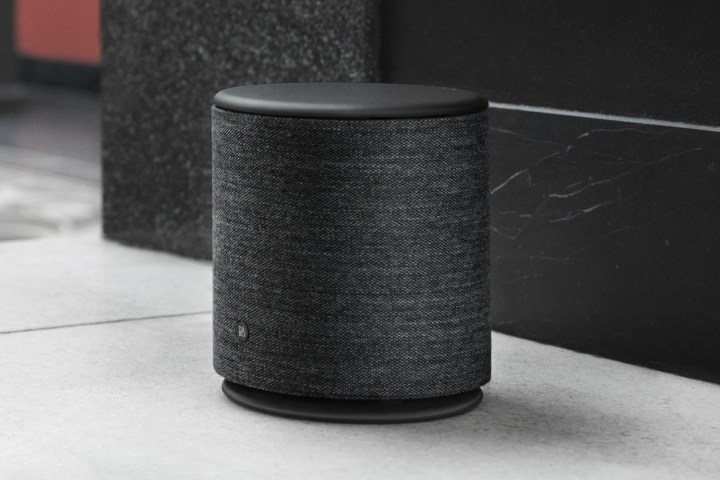
Thumping bass, sweet style, and multiple connectivity options define B&O Play’s new M5 multiroom speaker.
B&O Play is taking the idea of speakers not looking like speakers at all to the next level with the M5, its new wireless multiroom speaker system, launched at CES 2017. There’s no speaker grill, no volume buttons, and very few flashing lights. Stick this in the corner of the room, and almost regardless of your decor, it’ll disappear from view — until you turn it on and wake up the neighbors.
The M5 is a squat, cylindrical speaker that weighs over 5.5 pounds, and is covered in a material blended from wool. The speaker we checked out came in a grey color, but other options will be available so you can match your other soft furnishings. It’s textured to the touch, like a wool sweater, but our sample apparently wasn’t quite production ready, so the feel may change at launch.
The top is made from aluminum and twists to adjust the volume. It’s heavily dampened and doesn’t spin all the way round, moving just an inch or so in either direction. Press the top to play or pause music, or to link up an inactive M5 with other already connected M5 speakers in the house. The app can adjust sound modes to tailor performance depending on where the speaker is placed. For example, if it’s in a corner, the sound is dispersed in a different manner to when it’s in the open air.
The M5 will connect to your phone using Bluetooth, but its also Wi-Fi connected via Apple AirPlay and Google Cast, putting it up against Sonos speakers and a wide variety of others from LG, Sony, and Harman Kardon. Spotify Connect is also included, along with support for B&O Play’s own Beolink Multiroom service. This wide choice means you can link many M5’s together for music throughout the house, almost regardless of your device or music service preference.
Whether you want to or not will depend on the sound. The M5 is a 360-degree speaker with three three-quarter-inch tweeters, a single 1.5-inch mid driver, and a downward firing 5-inch subwoofer. This is hidden by a plastic cage on which the M5 stands, where the two LED lamps for connection and power are also hidden. There are four amps powering all the drivers. The woofer, mid, and prime front tweeter all have their own amp, while the rear-facing tweeters have another. All are rated at 30 watts, except for the woofer, which gets 40 watts.
The sound produced is clean, clear, and delivers a massive amount of bass for such a small design. Resting on a wooden table, at 75 percent volume the bass can be clearly felt through the floor with no distortion.
It’s loud too. Houkago Princess’s vocal-heavy My Love Song showcased the lead singer’s voice extremely well, with the breathy intro sounding superbly realistic. Streaming the main theme from Where Eagles Dare reproduced the wonderful, artillery-like thump that defines the piece perfectly. However, while the vocals in Mat Zo’s The Sky worked well, the M5 didn’t quite have the guts for the strong sub bass later in the track. That said, and although the design doesn’t suggest it, the M5 will function perfectly well for relaxed listening or as a full-on party speaker.
It’s turning the speaker upside down that you’ll encounter a few design issues. The power lead plugs in and then feeds through a cutout in the cage, but it’s not very neat, and it can be difficult to get it to stay in place after shifting the speaker around. The power button is also hidden away, accessed by lifting the speaker up, so you could encounter the frustrating power cable problem often. Use an Ethernet cable instead of Wi-Fi connection and it’ll have to go through the same small cutout as well. Not ideal, and an unfortunately messy solution.
Like all B&O Play equipment, the M5’s silky smooth aesthetic and audio tuning comes at a price: The speaker cost $600, or 530 British pounds, and will be sold through B&O Play’s website from January 5. The B&O Play M5 is very stylish, and comes with the right connectivity, along with a surprisingly bombastic sound. However, it’s up against strong competition in multi-room systems and other lifestyle speakers such as Sony’s super cool, but sonically very different, LSPX-S1 Glass Sound speaker.
Highs:
- Sweet design that doesn’t look like a speaker
- Thumping bass
- 360 degree audio
- Plenty of connectivity
Lows
- Expensive
- Poor cable management



